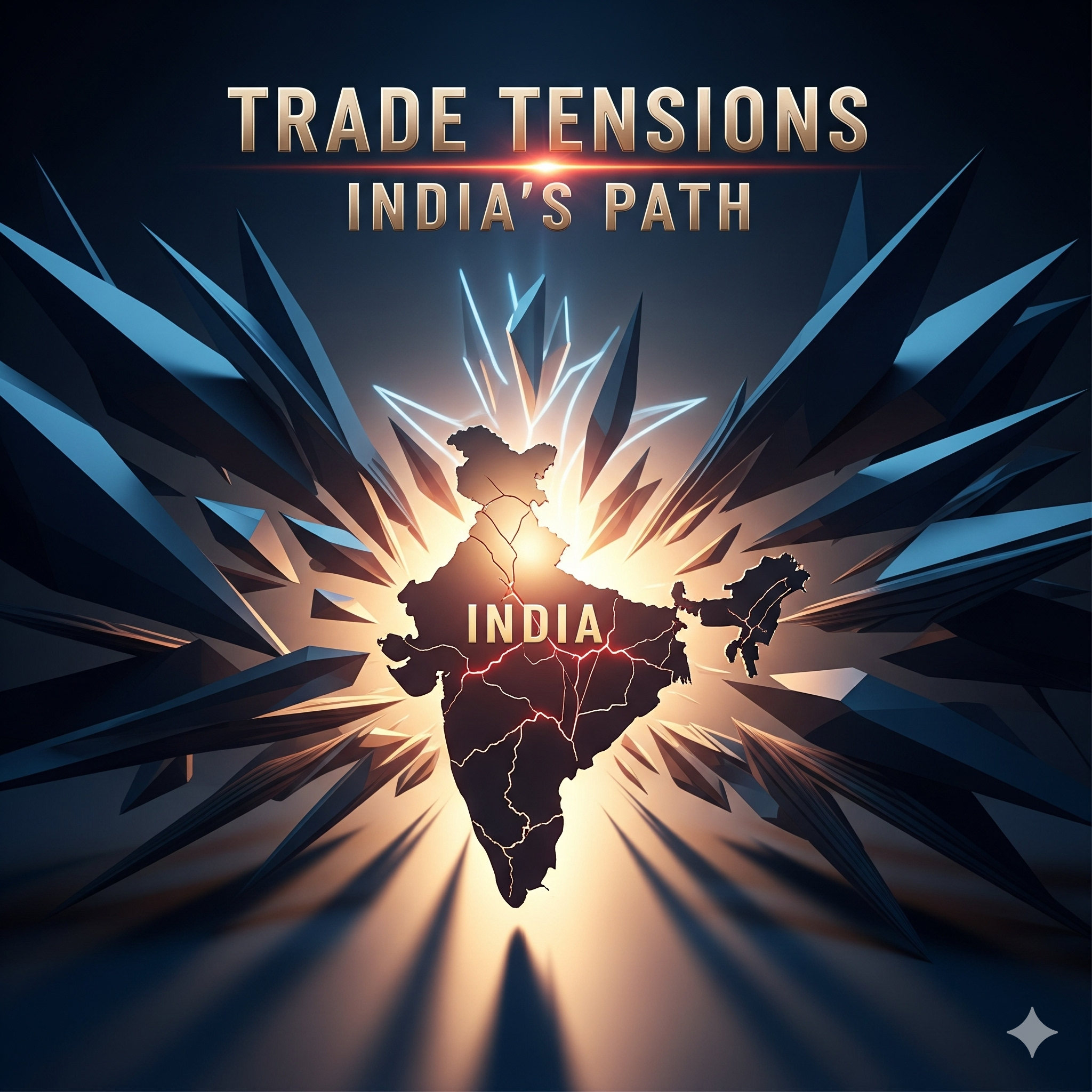Introduction
The global economy has become increasingly interdependent, with international trade serving as a lifeline for growth, industrialization, and technological advancement. However, this interdependence also exposes countries to external shocks arising from disputes between major economic powers. The U.S.-China trade war, which began in 2018, has been one of the most significant disruptions in the international economic order in recent years.
While the trade war primarily involves the world’s two largest economies, its ripple effects extend across Asia, Europe, Africa, and Latin America. For India, an emerging global power with deep economic linkages to both the United States and China, the trade conflict presents a combination of risks and opportunities. On the one hand, India faces the challenge of managing supply chain disruptions, fluctuating global demand, and geopolitical pressures to align with one side or the other. On the other, the trade war opens avenues for India to attract investments, expand exports, and reposition itself as a critical node in global value chains.
This essay examines the origins of the U.S.-China trade war, its global and Indian implications, the challenges India faces, and the strategies it can adopt to navigate these tensions while strengthening its position in the global trade architecture.
Understanding the U.S.-China Trade War
1. Background and Causes
The trade war between the U.S. and China emerged from long-standing disputes over:
- Trade imbalances: The U.S. trade deficit with China reached over $350 billion in 2017.
- Intellectual property rights: The U.S. accused China of forced technology transfers and IP theft.
- Industrial policy: China’s state-led industrial strategies, especially its “Made in China 2025” program, were viewed as threatening U.S. technological supremacy.
- Geopolitical rivalry: The competition for global influence added a strategic layer to the economic conflict.
2. Tariffs and Counter-Tariffs
- The U.S. imposed tariffs on Chinese goods worth more than $370 billion, targeting electronics, steel, machinery, and consumer goods.
- China retaliated with tariffs on U.S. agricultural products, automobiles, and industrial goods.
3. Global Ramifications
The dispute disrupted global supply chains, depressed global trade growth, and injected uncertainty into investment flows. Emerging economies like India were directly affected due to their dependence on both U.S. and Chinese markets.
India’s Economic Relations with the U.S. and China
- United States: India’s largest export destination, accounting for IT services, pharmaceuticals, textiles, and gems. The U.S. is also a major investor in India’s technology and defense sectors.
- China: India’s largest source of imports, particularly in electronics, machinery, active pharmaceutical ingredients (APIs), and chemicals. Although India exports raw materials and agricultural products to China, the trade balance is heavily skewed in China’s favor.
This dual dependency puts India in a delicate position when trade tensions escalate between Washington and Beijing.
Impact of the U.S.-China Trade War on India
1. Trade Diversion Opportunities
- As U.S. tariffs reduced demand for Chinese goods, American companies sought alternative suppliers.
- Sectors like textiles, chemicals, and electronics in India were seen as potential beneficiaries.
- Similarly, China’s reduced access to U.S. agricultural products opened limited space for Indian farm exports.
2. Supply Chain Disruptions
- India’s reliance on Chinese intermediate goods—such as APIs for pharmaceuticals and electronic components—meant that any disruption in China’s trade flows created bottlenecks for Indian industries.
3. Investment Reallocation
- Global companies, particularly in electronics, began considering “China+1” strategies to diversify manufacturing bases.
- India, along with Vietnam, Indonesia, and Mexico, emerged as potential destinations for investment relocations.
4. Volatile Global Demand
- The slowdown in global trade growth reduced demand for India’s exports across multiple sectors.
- Fluctuating oil prices, partly influenced by trade tensions, added to India’s import bill.
5. Diplomatic Pressures
- India faced subtle pressure to align more closely with the U.S. to counterbalance China.
- At the same time, geographic proximity and economic interdependence required India to maintain stable ties with Beijing.
Challenges for India
1. Structural Trade Deficit with China
India’s imports from China are dominated by high-value, technology-intensive goods, while exports are primarily low-value raw materials. This imbalance limits India’s bargaining power.
2. Limited Manufacturing Competitiveness
Unlike Vietnam or Mexico, India has struggled to fully capitalize on trade diversion due to infrastructural bottlenecks, regulatory hurdles, and higher logistics costs.
3. Dependence on Imported Technology
India’s reliance on Chinese electronics, mobile components, and APIs exposes vulnerabilities. Even with opportunities, scaling up domestic manufacturing remains slow.
4. Geopolitical Risks
Border tensions, particularly after the 2020 Galwan clash, complicate India-China trade dynamics. Simultaneously, India must avoid overdependence on the U.S. given its history of protectionist policies.
5. WTO Constraints
As a member of the World Trade Organization (WTO), India must balance its domestic industrial policies with global trade commitments, limiting its room for aggressive protectionist measures.
Strategies for India to Navigate U.S.-China Trade War Pressures
1. Trade Diversification
- Expanding export markets in Africa, Latin America, and ASEAN to reduce dependence on the U.S. and China.
- Leveraging FTAs with countries like Australia, UAE, and the EU to gain preferential access.
2. Strengthening Domestic Manufacturing
- Promoting the Atmanirbhar Bharat (self-reliant India) initiative to reduce dependency on imports.
- Boosting electronics, pharmaceuticals, renewable energy, and defense manufacturing under Production-Linked Incentive (PLI) schemes.
3. Attracting Investment through “China+1” Strategy
- Improving ease of doing business and reducing bureaucratic delays.
- Establishing industrial corridors and clusters to attract global firms shifting from China.
- Building infrastructure for logistics and supply chains to match competitors like Vietnam.
4. Enhancing Supply Chain Resilience
- Encouraging domestic production of critical raw materials.
- Building partnerships with Japan, South Korea, and Taiwan in electronics and semiconductor supply chains.
5. Leveraging Diplomatic Balancing
- Maintaining pragmatic ties with both the U.S. and China while avoiding entanglement in their rivalry.
- Positioning itself as a neutral, reliable partner in global supply chains.
- Actively participating in forums like G20, BRICS, and QUAD to diversify geopolitical partnerships.
6. Promoting High-Value Exports
- Moving beyond raw materials to high-value goods such as biotechnology, green hydrogen, IT-enabled services, and defense exports.
- Investing in R&D and innovation to increase competitiveness.
7. Strengthening WTO Engagement
- Advocating for reforms in global trade governance that address protectionist practices.
- Using WTO mechanisms to safeguard Indian interests against arbitrary tariffs.
Case Studies
Case Study 1: Vietnam as a Trade War Winner
Vietnam’s nimbleness in attracting U.S. and Chinese investments during the trade war highlights how proactive reforms can help smaller economies thrive. India can learn from Vietnam’s flexible policies, infrastructure development, and FTA-driven export strategies.
Case Study 2: India’s Pharmaceutical Sector
Despite heavy dependence on Chinese APIs, Indian pharma successfully expanded its presence in the U.S. market, demonstrating the importance of cost advantages, compliance with international standards, and product diversification.
Case Study 3: Electronics Manufacturing in India
India’s success in attracting smartphone assembly plants, particularly by Apple and Samsung, shows the potential of leveraging global trade shifts with strong policy support.
Long-Term Outlook for India
- Opportunities: If India can scale up manufacturing, improve infrastructure, and diversify exports, it can emerge as a major beneficiary of the U.S.-China trade war.
- Risks: Failure to reduce import dependence, particularly on China, could leave India exposed to future geopolitical and trade shocks.
- Diplomatic Balancing: India’s success lies in maintaining strategic autonomy while leveraging its partnership with both Washington and Beijing for economic gains.
- Sustainability Factor: With climate policies reshaping trade, India must align with green technology exports to remain competitive.
Conclusion
The U.S.-China trade war is more than a bilateral dispute; it is a manifestation of deeper shifts in the global order where economic power is intertwined with strategic rivalry. For India, caught between two economic giants, the trade war presents both a challenge and an opportunity.
By addressing structural weaknesses, promoting domestic self-reliance, diversifying export markets, and skillfully balancing diplomatic relations, India can not only withstand the pressures of the U.S.-China trade war but also reposition itself as a leading player in global trade.
India’s path forward will depend on its ability to act with strategic foresight, economic resilience, and diplomatic pragmatism, ensuring that trade tensions between great powers become a springboard rather than a stumbling block for its own rise in the global economy.




